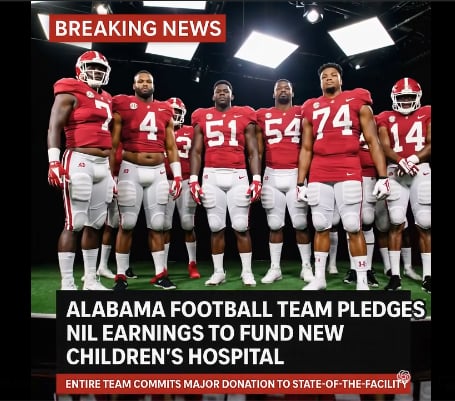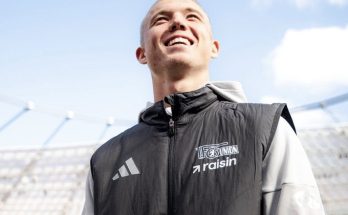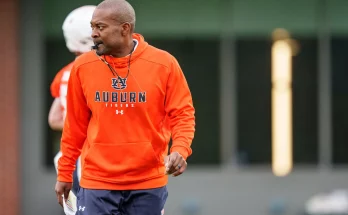Bigger Than the Game: Alabama Football Unites to Build Children’s Hospital Using NIL Funds
In a college football era often criticized for its shifting priorities and growing commercialization, the Alabama Crimson Tide just changed the narrative in a way that few saw coming. In a move that has stunned fans, shaken critics, and inspired communities across the country, the University of Alabama football team has announced they are collectively allocating a substantial portion of their NIL earnings to help fund the construction of a new state-of-the-art children’s hospital in Tuscaloosa. Not for headlines. Not for profit. But because, according to players and coaches, it was simply the right thing to do.
This isn’t a token gesture or a one-time charity check. This is an unprecedented, coordinated, athlete-driven initiative—a decision by the players themselves to leverage their newfound earning power for something bigger than any touchdown or championship trophy. The hospital, slated to begin construction in early 2026, will serve not only the children of Alabama but also families across the southeastern United States who often travel hours for pediatric specialty care. The athletes’ decision is rooted in compassion, unity, and an unshakable sense of purpose.
When the news first broke, the natural reaction was disbelief. In an age where NIL—name, image, and likeness—deals are regularly associated with car commercials, endorsement contracts, social media promotions, and personal branding, the idea that an entire team would willingly pool portions of their earnings toward a humanitarian cause was hard to grasp. But as the story unfolded, the motivations behind it became crystal clear—and deeply moving.
The spark came last winter, in the quiet corner of a hospital room where All-SEC offensive lineman Marcus Green was visiting his five-year-old cousin, diagnosed with a rare autoimmune disease. Green, known for his brutal strength on the field, sat in helpless silence as doctors delivered sobering news to his family. He watched nurses work overtime in cramped quarters, saw worried parents sleeping in chairs, and noticed how the hospital’s pediatric wing was stretched beyond capacity. That moment, he says, “changed everything.”
Green returned to campus with a burden he couldn’t shake. He confided in senior quarterback Ty Simpson, who’d recently lost a childhood friend to leukemia. Within days, a conversation between two teammates grew into a team-wide movement. Players from every position group began sharing stories, some deeply personal. Freshman wide receiver Keelon Russell spoke about his older sister, who spent her teenage years in and out of pediatric cancer units. Defensive captain Caleb Harris shared how a life-threatening asthma attack almost took his little brother’s life—only to be saved by an overworked rural clinic.
These weren’t just stories. These were realities. And they lit a fire inside the Alabama locker room that no motivational speech could match.
Coach Kalen DeBoer, new to Tuscaloosa but already admired for his leadership, didn’t initiate the idea—but he embraced it fully. When the players approached him in late spring with their proposal, he sat in stunned silence for nearly a minute before offering only two words: “Let’s build.”
And so they did.
Through the summer months, Alabama players and staff worked behind the scenes with university officials, local health care leaders, pediatric specialists, and architects. The plan took shape rapidly. The Crimson Cares Children’s Hospital—named in honor of the team’s initiative—will be built on a 12-acre lot near DCH Regional Medical Center. It will feature more than 100 inpatient pediatric beds, emergency and trauma services, surgical suites, neonatal and pediatric intensive care units, a family housing wing, and a medical education center. It’s projected to be one of the largest and most advanced children’s hospitals in the Deep South.
The initial funding—an estimated $12 million—will come directly from the NIL contributions of more than 85 active Alabama players, ranging from nationally recognized stars to walk-ons. Some are giving 10% of their endorsement deals. Others have pledged flat amounts. Several top-earning players, including Simpson, Green, and Russell, have donated six-figure sums. Former Alabama players in the NFL have also joined in support. Bryce Young, Tua Tagovailoa, and Jalen Hurts were among the first to back the effort publicly, and each has committed donations of their own.
The university, touched and energized by the players’ initiative, has agreed to match all athlete donations up to $25 million. Additional support has come from sponsors and philanthropic organizations eager to align with what’s now being called one of the most inspiring player-led efforts in the history of college athletics.
What makes this story even more remarkable is the total absence of ego. No one’s name is going on the building. There will be no “Simpson Wing” or “Green Pavilion.” Players insisted that the hospital exist as a gift—not a monument.
Even the internal rollout of the plan reflected this humility. When the players first announced the initiative to the public during a press conference, there were no extravagant suits, no flashy presentation slides. Just 30 players—shoulder to shoulder, dressed in Alabama polos—standing behind their quarterback as he explained why they were doing it.
Simpson spoke softly but firmly.
“We get a lot of attention for what we do on Saturdays,” he said. “But when the season ends, we’re still people. We’re brothers. Sons. And a lot of us are uncles. We know what it means to worry about a kid you love. We know what it feels like to sit in a hospital waiting for news you can’t control. This is something we can control. So we’re doing it.”
Social media, predictably, erupted with praise. “Faith in humanity: restored,” one user wrote. “This is how NIL was supposed to work,” said another. Sports talk shows that often traffic in hot takes and scandals were suddenly flooded with praise for Alabama’s players—not for what they did with a football, but for what they chose to do with their hearts.
But for the Alabama players, this isn’t about headlines. In fact, many of them declined individual interview requests. As Green said, “It’s not about us. It’s about those kids. And it always will be.”
The impact of the initiative is already being felt far beyond Alabama. Other programs across the country have begun exploring similar opportunities. Coaches from programs in the Big Ten, ACC, and Big 12 have quietly contacted Alabama officials to learn how the project came together. Student-athlete groups are discussing how NIL funds might be used for other socially transformative purposes—from food insecurity to educational outreach.
In this moment, Alabama football has reminded the world that college athletes are more than just performers. They are leaders, thinkers, and—increasingly—philanthropists. They’ve proven that NIL doesn’t have to be a symbol of selfishness. It can be a tool for change. A vehicle for hope. A reason to believe.
And it all started with one offensive lineman, in one hospital room, seeing something that broke his heart—and deciding not to ignore it.
The hospital is scheduled to open its doors in the fall of 2028. By then, most of the players who led this initiative will have moved on—some to the NFL, others into life beyond football. But their impact will live on in every hallway, every examination room, every child who walks through those glass doors.
For every touchdown they score this fall, for every game they win, they’ll carry the knowledge that their legacy won’t be limited to scoreboards or championships. Their legacy will live in laughter echoing through a pediatric playroom. In parents holding their kids through the night in a place that feels safe. In healing.
Alabama football has always been about pride, tradition, and dominance. But this season, it’s about something more. It’s about humanity. About heart. About redefining what power looks like when it’s used not to glorify the self—but to lift up others.
They said it was bigger than football. And they meant it.



